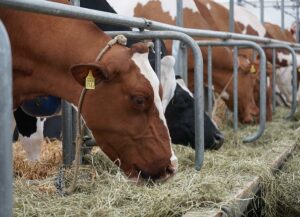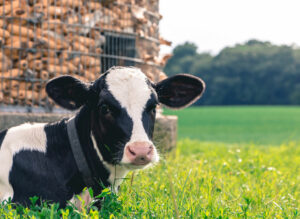Joaquín Ventura García & Fernando Diaz
Although farming really produces less than 10% of greenhouse gas emissions, several recently published news point at animal production as one of main polluting sectors. Several attempts have been made to reduce dairy cow methane emissions such as adding plant oils containing high levels of polyunsaturated fatty acids or seaweed to the diets. These methods based on the addition of dietary supplements have an immediate effect but only work while the supplement is fed. In comparison to feeding strategies, breeding schemes based in methane emissions level need more time to have an impact, but they are cumulative and permanent.
Greenhouse level emissions is a heritable trait in ruminants and measuring methane production reveals considerable variability among individuals fed the same diet. If these differences would be consistent over time and with different diets, animal breeding might be a successful strategy to reduce methane emissions in dairy cows.
A study published in Journal of Dairy Science this year investigated the persistence of differences in methane emissions between dairy cows categorized as either low- or high- emitters for 5 months. The experiment was conducted at the Agroscope (Posieux, Switzerland) with twenty multiparous lactating Holstein Friesian cows. These cows were kept in a freestall barn with access to pasture for first 3 months, and indoor for last 2 months of the experiment.
The cows grazed in a rotational system daily from 8:00 to 14:00 and from 18:00 to 4:30 hours. The pasture sward consisted mainly of grasses [76; English ryegrass (Lolium perenne) and smooth meadow-grass (Poa pratensis)], with some legumes [16%; white clover (Trifolium repens) and red clover (Trifolium pratense)] and herbs [8%; common dandelion (Taraxacum officinale)]. Once the cows finished the pasture period, they received a diet composed of corn, grass, and alfalfa silage (39.2%, 27.4%, and 13.6%), hay (13.2%), and soybean meal (6.6%). Fresh water, a vitaminized mineral mixture, and salt were available at all times.
Methane emissions were estimated with a GreenFeed system. This is an automated head-chamber system that measures methane and carbon dioxide from the breath of cows. It offers small portions of feed to attrack the cows several times daily, and every time the animal visits the GreenFeed station a fan system drives the air exhaled by the cow to a device that measures its gas concentration.
Cows were allowed to visit the GreenFeed feeding station a maximum of 6 times a day (1 visit/3-hour time) and they were encouraged to stay by releasing up to 8 portions of 32 g of bait feed (pelleted dried whole corn plant) per visit. The researchers (Denninger et al., 2019) reported these results:
- The 10 cows categorized as low emitters had 11% lower initial methane emissions than cows in the high emission category based on GreenFeed measurements (426 vs. 478 g/day).
- Low emitting cows had 18% lower methane emissions level per kg of energy corrected milk (ECM; 14.5 vs 17.8 g/kg).
- On average, low emitting cows produced 4% more ECM (30.4 vs. 29.3 kg ECM/d).
- During the grazing season, low- and high-emitting cows showed similar dry matter intake (17 kg/day) and ruminating time (400 min./day). However, the low-emitting cows spent less time eating (620 min/day) than the high emitting cows (671 min/day).
- Interestingly, differences between low and high methane emitting cows were persistent over time (5 months), and across 2 contrasting feeding regimens.
These findings indicate that it might be useful to categorize daughters of bulls in progeny testing based in methane emissions. However, the researchers believe more studies are needed with more precise measurements to show whether the accuracy of the prediction of methane emissions from individuals is sufficient to be useful in breeding program.
Reference
M. Denninger, F. Dohme-Meier, L. Eggerschwiler, A. Vanlierde, F. Grandl, B. Gredler, M. Kreuzer, A. Schwarm, and A. Münger. Persistence of differences between dairy cows categorized as low or high methane emitters, as estimated from milk mid-infrared spectra and measured by GreenFeed. J. Dairy Sci. 102:11751–11765.
© 2019 Dairy Knowledge Center, LLC. All Rights Reserved.











